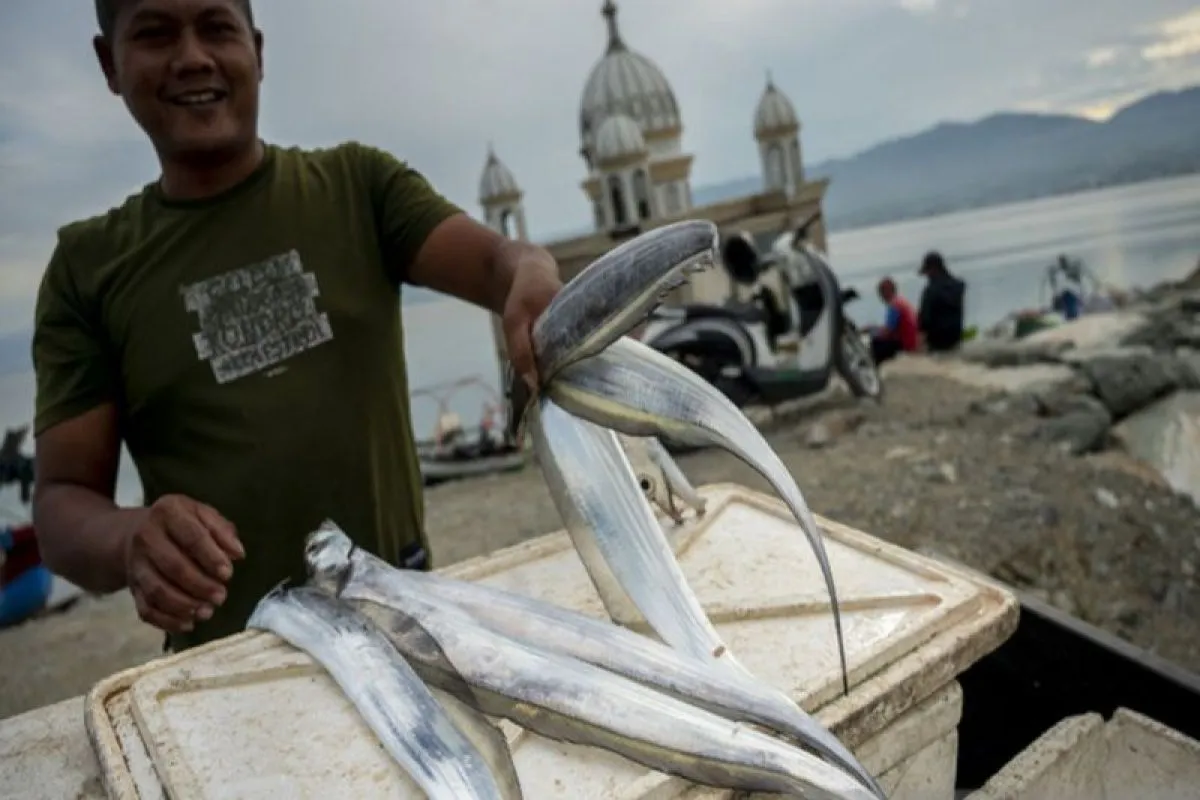Live Streaming
Program Highlight
Company Profile
Supporting food sufficiency through blue economy
Written by Ahmad Faisal

Documentation—A trader shows 'luyur' fish (Trichiurus lepturus) collected from the beach at Kampung Lere, Palu, Central Sulawesi, on August 10, 2021. (ANTARA/Basri Marzuki)
VOI News, Jakarta: Food self-sufficiency is among the Asta Cita missions of President Prabowo Subianto and Vice President Gibran Rakabuming Raka.
Considering food as a primary need of the people, the government has begun preparing several strategies to build food self-sufficiency by 2028.
As reported by Antara News Agency (1/11), a number of ministries are working together to prepare a roadmap toward the noble mission, such as the Ministry of Agriculture, Ministry of Maritime Affairs and Fisheries, Ministry of Forestry, Ministry of Environment, National Nutrition Agency, Ministry of Public Works, Ministry of Villages and Development of Disadvantaged Regions, and the National Food Agency.
Amid the efforts to build food self-sufficiency, especially in staple foods, it is worth noting that Indonesia—as a maritime country blessed with a total sea area of more than 5.8 million square kilometers—has abundant underwater food resources.
The underwater resources also have diverse nutritional content that can support national food security as well as support human resource development through fish protein intake.
Source of nutrients
The nutritional content of fish, especially sea fish, is known to benefit growth. Fish are also rich in essential amino acids.
According to medical nutritionist Dr. Dyah Arum, sea fish, such as anchovies, mackerel, skipjack tuna, grouper, and ribbon fish, have high arginine content.
Arginine is an amino acid that helps support the growth of or increase in the height of children. In addition, it can help increase bone length.
Small fish, such as anchovies, have a calcium content of up to 2 thousand mg per 100 grams, which is far above that of milk. Long known as a good source of calcium, milk has 100 mg of calcium per 100 grams.
Unsalted anchovies can be an alternative source of calcium as their price in the market tends to be more affordable compared to milk.
Given the wealth of the sea, sea fish spread across various regions in Indonesia can support the food sufficiency target.
Freshwater fish are no less nutritious and can be considered a protein source for the community that can increase the quality of food intake.
Freshwater fish can also be a source of proteins. For example, catfish have a good fat content and are rich in omega 3.
Increasing production
Indonesia's natural marine wealth is indeed a blessing for its people. The Ministry of Marine Affairs and Fisheries has initiated a movement to popularize eating fish and educate the people about including fisheries products in their daily menus.
While the utilization of sea fish to boost nutrition is permissible, in the process, it is also necessary to implement fishing practices that focus on the sustainability of fish resources, including the underwater world.
Fishing should be carried out in environmentally friendly ways so that the areas where fish live and breed can be maintained.
Based on data from the Ministry of Maritime Affairs and Fisheries, in the first half of 2024, capture fisheries production reached 3.11 million tons of seawater fish catch and 0.23 million tons of inland water fish catch.
The increase was recorded at 12 central technical implementation units fishing ports and 66 regions dominated by sea fish, including tuna, skipjack, mackerel, and scad.
Meanwhile, the target for capture fisheries production for 2024 is 6 million tons — 5.64 million tons for seawater fish catch and 0.38 million tons for inland water fish catch.
With this achievement, state revenue from capture fisheries as of July 26 was recorded at Rp533.36 billion against the target of Rp1.85 trillion.
Meanwhile, in the January–June 2024 period, production in Indonesia's aquaculture sub-sector reached 3.34 million tons, or 26.6 percent of the target of 12.5 million tons.
With the achievement of aquaculture still far from the target, the Ministry of Marine Affairs and Fisheries has prepared a strategy to accelerate performance, so that the target can be met in the second half.
Aquaculture commodities are supported by seaweed commodities (5.14 million tons), snapper (3,860 tons), tilapia, catfish, milkfish, carp, gourami, and grouper.
Given the abundance and variety of marine and fishery commodities, it is only right for Indonesia to utilize the wealth of underwater food resources.
When it comes to taste, fish protein consumption can be increased through diversification so that people have a variety of food menus.
In fact, data from the World Food Agency (FAO) shows that the world's population is experiencing a food shortage, with hunger affecting 7.9 percent of people globally in 2019 and 9.2 percent in 2022. This is also predicted to increase the world's protein needs by 70 percent.
The wealth of fish resources is also expected to support the world's protein needs, which are projected to increase.
Before moving on to meet the world's protein needs, it would be good to introduce fish proteins more closely to the domestic community, so they can become king in their own country. (Antara)



